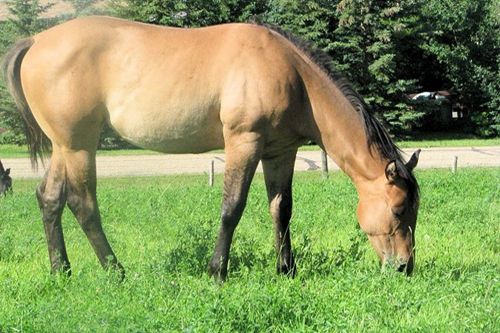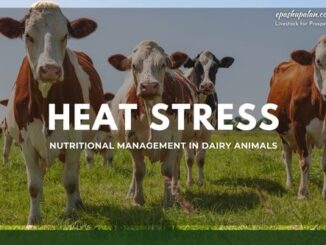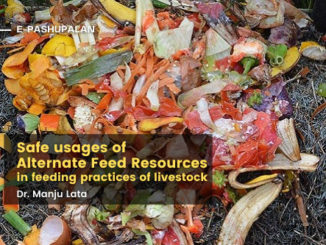Introduction
Summer season predisposes a horse to heat stress, sunburns and disturbance due to increased insect activity in the barn. These factors cause discomfort to horse and also affect their welfare. Generally horses are more tolerant to hot weather in comparison to cattle and they can keep themselves cool very effectively under normal conditions during summer season. However, they are not tolerant to sunburns (especially light colored horses) and disturbance due to high insect activity in the barn that makes these conditions to be managed well.
Horses produce the heat in their body during processes of body maintenance and several basic body functions, their metabolism and their performances (training and competition). More than 50% of the energy that is available in the muscles is converted into heat. This heat is normally lost through sweating, evaporation and convection, but is fully dependent on the ambient temperature and the air humidity. The normal rectal temperature of a horse is 38±0.5 °C (100±8.6 °F); this value is deduced from the muscle temperature which on its turn is deduced from the deep body temperature (metabolism). During heat stress situations, the rectal temperature increases.
Sweating is the primary mean of thermoregulation in horses and 65% portion of horse’s cooling process can be attributed to the sweating during the summer heat. This further depends upon the ambient temperature and relative humidity. As humidity rises there is less sweat evaporation and effectiveness of cooling mechanism in horses is affected.

The occurrence of Heat Stress
Horses have a thermo- neutral zone between 5 °C (41 °F) and 20 °C (70 °F) there is some individual variation. Thermo-neutral means that at these temperatures the horses can easily get rid of the heat that is produced in the body. At higher (but also at lower) temperatures changes do occur inside the body. The body tries to adapt itself to the new, undesired situation. At 20 °C (71 °F) and above we state that heat stress starts; it becomes more severe when temperature increases and/or relative air humidity increases. Under heat stress, the horses produce more heat in the body than they can get rid of. Most heat is lost through sweating and evaporation at the skin surface (65%); the rest mainly through the lungs and respiration (25%).The core problem in heat stress is the loss of water and electrolyte. Horses feel best at temperatures between 10 °C and 18 °C (50 to 70 °F); this range is called the “thermo-comfort acceptable threshold level for sport horses is around a THI of 68; above this value heat stress is present and risks occur. Under heat stress condition the horses can show the signs such as dehydration, muscle spasms and the development of colic. Horses can also become heat stressed and heat stroke can occur which is a more critical condition and if not treated in time the death may occur. This heat production due to muscular work along with external factors like high temperature and high humidity will hamper the normal response to heat stress that is increase in sweating rate, increase in movement of blood to capillaries under the skin and increase in respiratory rate. Thus, the horses are unable to cope up with the hot environment and heat stress management and treatment become necessary to save their life.
Factors Responsible for Heat Stress
There are various factors like hot & humid weather , poor ventilation, excessive work load, Intense exercise, dehydration, heat generated in muscles, transport stress, insufficient time to acclimatize to warm climate, excessive time spent in direct sunlight and obesity which can lead to heat stress in horses. Horses under heat stress commonly shows that skin becomes hot and dry, horse lacks major cooling system (evaporation), rapid heart rate at rest (>50) , rapid breathing at rest (>20/ minute) and high rectal temperature (104 °F).
Nutritional Strategies to combat Heat Stress in horses
Several Strategies which may contribute to the prevention of the negative effects of heat stress on performance, welfare and health can be taken in practice. These measures are divided into three domains:
- Feed and drinking water
- Stable climate and
- General
Provision of fresh clean water throughout the day
The average horse will intake 5 to 10 gallons of fresh water per day. Just like humans, different horses crave or need different water amount intakes. This water need can get doubled during summer season depending on your horse’s activity level, health, and food. A temperature of 100 °F increases the water requirement of the horse to approximately 20 gallons/ day. Horses prefer water kept at temperatures below the ambient temperature during hot weather. Placing water tanks in shaded areas will help maintain lower water temperatures. Therefore, make sure that your horse is getting enough clean, fresh and cool water to stay hydrated enough throughout the day.
Electrolytes supplementation
When horses sweat they lose body salts (electrolytes) in addition to water. Horses should have free access to salt at all times. Salt (NaCl) aids the body in fluid and temperature regulation. In hot weather, the temperature of the body is controlled by sweating. Water, salt, and other minerals are given off and need to be replenished. The salt intake of a horse is directly proportional to the water intake. It is vital to have salt available for horses either as a block, loose, or mixed in the feed. This is best done in the form of iodized salt or trace-mineralized salt. Allow free access to loose or block trace mineralized salt with selenium as horses will consume the amount they need as long as they have access to plenty of water. All horses require about 1 ounce of salt daily that provides at least 1 ppm of selenium in the total ration. Improper dietary levels of these trace minerals, especially Cu, Zn, Fe, and Mn are thought to contribute to developmental orthopedic diseases such as osteochondrosis desecans (OCD), physitis, and contracted tendons.
Provision of Fresh Feed throughout the day
Provide at least 1.0 pound of forage per 100 pounds of body weight per day. The total amount of feed should be approximately 2.5-3.0 pounds/100 pounds of body weight per day. Prevention of overheating during summer the horses should be provided regularly with electrolytes in hot weather, amount of grains in the ration should be decreased and forages should be increased as it can lead to reduction in heat production inside the body. Owner can switch towards supplementation of high fat feed or can add high fat supplement in the horse’s diet. Fat is digested, absorbed and metabolized more efficiently than any other nutrient and it produces less metabolic heat. There are various readymade feed formulations available for feeding during hot weather which contains the fat content up to 25%. Avoid dusty and moldy hays and grains. Dusts and molds can contribute to indigestion and respiratory problems. Moldy corn poisoning (leukoencephalomalacia) is caused by a mycotoxin called Fumonisin that can be in corn and is worse in the damaged, dusty kernels and fines. Use top quality feeds, and select or formulate rations balanced to exact nutrient requirements according to the size, age, work, gestation, etc. Never give grain or water to a hot horse in large doses. Frequent sips of water will speed up the cooling time and potentially avoid dehydration.
Provision of shade
Horses under shed obviously have shade all the time but they also need shade when they are turned out for grazing during daytime. Provision of shade can help in prevention of direct sun exposure to the horses. Pastures covered with good trees can provide a good environment to the horses during grazing. Shade can provide relief against heat stress and sunburns in the horses. Provision of watering facilities should also be in the shaded areas of pastures.
Cooling of an overheated horse
Prolonged exposure to high temperatures can result in heat stress, heat stroke and problems like dehydration, muscle spasms and colic. First step in such cases should be to stop all kind of activities and move the horse to shady area and provide the fans in the area to create wind flow and proper ventilation. Cold water should be used to spray the legs and the body of the horse should be hosed with the cold water. After hosing the water layer must be scraped off from the body as it may block the heat loss from the body. Horse should be allowed to drink small quantity of water frequently and electrolytes should be provided for rehydration and to maintain the electrolytes balance in the body. If the condition is severe then a veterinarian must be approached for further treatment. He can provide cold water enema to horses as well as can provide treatment for dehydration which can help in cooling down the temperature.
Conclusion
It can be concluded that nutritional strategies discussed above have good impact in horse in high temperature and humidity during summer season.






Be the first to comment